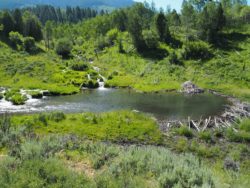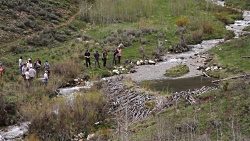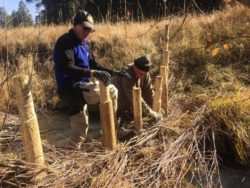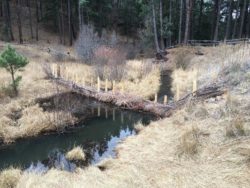
Courtesy Pixabay, “Tom” a.k.a. Analogicus, Contributor
A community of trees has much in common with human communities. Trees nurture and protect one another through an intricate web of roots and mycelium. When one member of the community is suffering, other members will send resources to ward off attacks, and send water and nutrients to help the stressed tree recover.
By third grade you’ve probably learned they produce oxygen and absorb green house gases, cool the earth, filter the air, provide wildlife habitat. By fifth grade add protect watersheds, provide safe drinking water, protect communities from floods and landslides. Additionally, Older trees absorb and store more carbon dioxide than younger trees, helping us fight climate change. Many species of life are found only in mature old growth forests, adding to biodiversity. They provide banks of knowledge for complex ecosystems and blueprints for natural forest processes.
As a Wilderness Ranger and recreationist, I’ve trapsed through many of Utah’s Old Growth Forests. Thanks to our National Parks, Monuments, and other public lands, we have preserved remnants of Old Growth. Magnificent ponderosa pine yet exist in Zion and Bryce Canyon national parks. I’ve found pockets of Engleman spruce in the remote parts of our national forests, along with blue spruce on Cedar Mountain and south slope of the Uintahs along river corridors. Most of old growth Douglas fir was logged off in the late 1800s.
For myself, entering an old growth forest is a spiritual experience. I stand in awe while their majesty, deep history and resilience reach deep into my core. Silence sweeps over me, interrupted by bird song, squirrel chatter, and a whisp of wind in upper branches.
For Native American cultures that developed with, and in many cases shaped the old-growth forests, they harvested medicinal plants, berries, game, or old trees and bark for ceremonial or practical use. They would tend the forest to improve ecosystem services, occasionally burning forests to complementing its utilitarian value.
Thus my alarm sounded when the U.S. House of Representatives recently passed legislation that would fast-track logging projects on federal lands, and the U.S. Forest Service has proposed opening hundreds of thousands of acres of mature (old growth) forests to commercial logging. R oads built through it will take centuries to recover. Our old growth forests are worth far more standing- economically, and for ecosystem services they provide.
Logging is warranted in younger forests, and for fire breaks near human development, while protecting water and airsheds, and sensitive species, but please, please allow Old Growth forests to continue on for the centuries it took to create them!
Jack Greene for Bridgerland Audubon Society, and I’m Wild about Utah’s Old Growth Forests!
Credits:
Picture: Forest, Courtesy Pixabay, "Tom" a.k.a. Analogicus, Contributor
Audio: Courtesy & © Kevin Colver https://wildstore.wildsanctuary.com/
Text: Jack Greene, Bridgerland Audubon, https://bridgerlandaudubon.org/
Additional Reading: Lyle W Bingham, Webmaster, and Jack Greene, Author, Bridgerland Audubon, https://bridgerlandaudubon.org/
Additional Reading:
Jack Greene’s Postings on Wild About Utah, https://wildaboututah.org/author/jack/
Popkin, Gabriel, How much U.S. forest is old growth? It depends who you ask, Science, American Association for the Advancement of Science (AAAS), 26 Apr 2023, https://www.science.org/content/article/how-much-u-s-forest-old-growth-it-depends-who-you-ask
Franklin, Marcy, “The benefits of public wildlands, explained,” Vox, October 9, 2017. https://act.environmentamerica.org/go/6644?t=4&akid=6407%2E1385290%2EtS_2YB
Original: https://www.vox.com/ad/16447278/wildlands-benefits-protection
US House of Representatives, “H.R.471 – Fix Our Forests Act,” Congress.gov, March 6, 2025. https://act.environmentamerica.org/go/4036?t=5&akid=6407%2E1385290%2EtS_2YB
Mapes, Lynda V., “Proposed changes would allow more logging on federal land in Northwest,” Seattle Times, December 23, 2024. https://act.environmentamerica.org/go/4787?t=6&akid=6407%2E1385290%2EtS_2YB
Original: https://www.seattletimes.com/seattle-news/climate-lab/proposed-changes-would-allow-more-logging-on-federal-land-in-northwest/
Montgomery, Ellen, and English, Amelia, “The “Fix Our Forests Act” won’t actually fix our forests,” Environment America, January 22, 2025. https://act.environmentamerica.org/go/1541?email_blast=-10076407&t=7&akid=6407%2E1385290%2EtS_2YB
Original: https://environmentamerica.org/articles/the-fix-our-forests-act-wont-actually-fix-our-forests/
Ehrlich, April, “Northwest Forest Plan update continues, despite termination of national old growth proposal,” Oregon Public Broadcasting, January 8, 2025. https://act.environmentamerica.org/go/4786?t=8&akid=6407%2E1385290%2EtS_2YB
Original: https://www.opb.org/article/2025/01/08/northwest-forest-plan-update-continues-despite-termination-of-national-old-growth-proposal/













